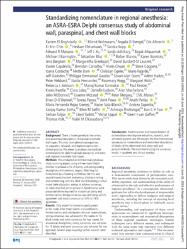| dc.contributor.author | El-Boghdadly, Kariem | |
| dc.contributor.author | Wolmarans, Morne | |
| dc.contributor.author | Stengel, Angela D | |
| dc.contributor.author | Albrecht, Eric | |
| dc.contributor.author | Chin, Ki Jinn | |
| dc.contributor.author | Elsharkawy, Hesham | |
| dc.contributor.author | Kopp, Sandra | |
| dc.contributor.author | Mariano, Edward R | |
| dc.contributor.author | Xu, Jeff L | |
| dc.contributor.author | Adhikary, Sanjib | |
| dc.contributor.author | Altıparmak, Başak | |
| dc.date.accessioned | 2021-06-22T11:42:05Z | |
| dc.date.available | 2021-06-22T11:42:05Z | |
| dc.date.issued | 2021 | en_US |
| dc.identifier.citation | El-Boghdadly K, Wolmarans M, Stengel AD, et alStandardizing nomenclature in regional anesthesia: an ASRA-ESRA Delphi consensus study of abdominal wall, paraspinal, and chest wall blocksRegional Anesthesia & Pain Medicine 2021;46:571-580. | en_US |
| dc.identifier.uri | http://dx.doi.org/10.1136/rapm-2020-102451 | |
| dc.identifier.uri | https://hdl.handle.net/20.500.12809/9330 | |
| dc.description.abstract | Background There is heterogeneity in the names and anatomical descriptions of regional anesthetic techniques. This may have adverse consequences on education, research, and implementation into clinical practice. We aimed to produce standardized nomenclature for abdominal wall, paraspinal, and chest wall regional anesthetic techniques.
Methods We conducted an international consensus study involving experts using a three-round Delphi method to produce a list of names and corresponding descriptions of anatomical targets. After long-list formulation by a Steering Committee, the first and second rounds involved anonymous electronic voting and commenting, with the third round involving a virtual round table discussion aiming to achieve consensus on items that had yet to achieve it. Novel names were presented where required for anatomical clarity and harmonization. Strong consensus was defined as ≥75% agreement and weak consensus as 50% to 74% agreement.
Results Sixty expert Collaborators participated in this study. After three rounds and clarification, harmonization, and introduction of novel nomenclature, strong consensus was achieved for the names of 16 block names and weak consensus for four names. For anatomical descriptions, strong consensus was achieved for 19 blocks and weak consensus was achieved for one approach. Several areas requiring further research were identified.
Conclusions Harmonization and standardization of nomenclature may improve education, research, and ultimately patient care. We present the first international consensus on nomenclature and anatomical descriptions of blocks of the abdominal wall, chest wall, and paraspinal blocks. We recommend using the consensus results in academic and clinical practice. | en_US |
| dc.item-language.iso | eng | en_US |
| dc.publisher | BMJ Publishing Group | en_US |
| dc.relation.isversionof | 10.1136/rapm-2020-102451 | en_US |
| dc.item-rights | info:eu-repo/semantics/openAccess | en_US |
| dc.subject | ASRA-ESRA | en_US |
| dc.subject | Regional anesthesia | en_US |
| dc.title | Standardizing nomenclature in regional anesthesia: an ASRA-ESRA Delphi consensus study of abdominal wall, paraspinal, and chest wall blocks | en_US |
| dc.item-type | article | en_US |
| dc.contributor.department | MÜ, Tıp Fakültesi, Cerrahi Tıp Bilimleri Bölümü | en_US |
| dc.contributor.authorID | 0000-0002-8165-3438 | en_US |
| dc.contributor.institutionauthor | Altıparmak, Başak | |
| dc.identifier.volume | 46 | en_US |
| dc.identifier.issue | 7 | en_US |
| dc.relation.journal | Regional Anesthesia & Pain Medicine | en_US |
| dc.relation.publicationcategory | Makale - Uluslararası Hakemli Dergi - Kurum Öğretim Elemanı | en_US |


















